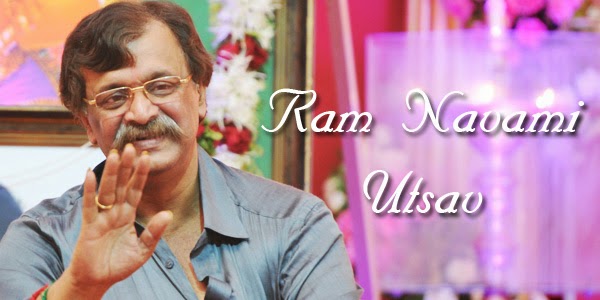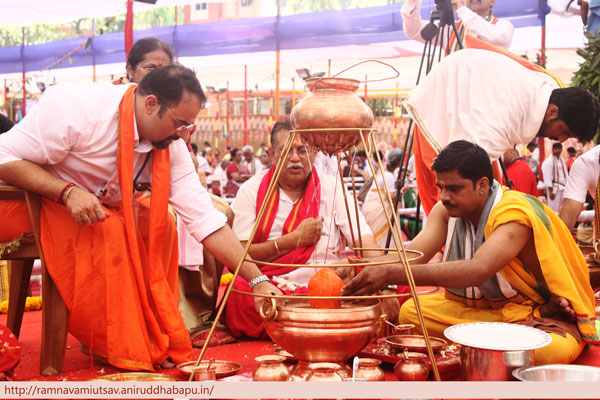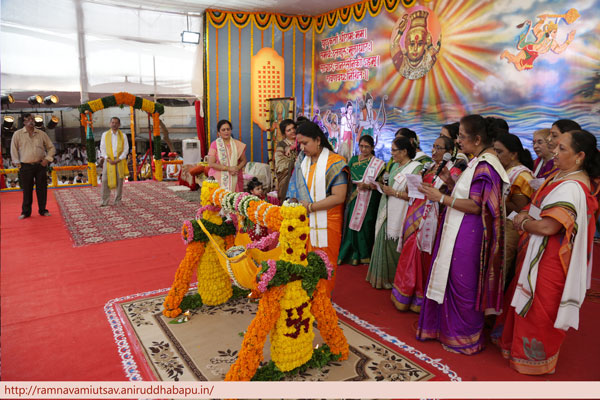 |
| How we celebrate Ramnavami Utsav? |
Shree Sahastradhara Abhishek:
 |
| Sahastradhara Abhishek on Renuka Mata on Ramnavami |
Sahastradhara Abhishek is performed by chanting mantras on 'Renukamata’s Tandala' by using a special Abhishekpaatra. It is indeed a great opportunity for all Shraddhavans to watch the Abhishek Sohala and listen to the mantras chanted.
Shree Sairam Sahastra Yadnya:
 |
| Aniruddha Bapu along with family taking darshan of Shree Sairam Sahastra Yadnya at Ramnavami Utsav |
In the morning, the ritual of Yadnya starts. This Yadnya is called ‘Shree Sairam Sahastra Yadnya’. Shree Deepshikha is brought from Sai Niwas to the venue. Every devotee can make an offering while chanting the Tarak Mantra. Due to the offerings, one’s body and mind obtain positive vibrations. Similarly, because the Mind also gets strengthened, the sins of one’s previous births get eradicated as well. ‘Aapatti Nivarak Sameedha’ is available during this Yadnya.
With the blessings of “Aadimata Mahishasurmardini”, Ram’s victory over Ravan was achieved. This story has been narrated in detail by Shree Aniruddha in Shree Matruvatsyalavindanam. Thus, the Poojan of ‘Shree Ramavardayini Aadimata Mahishasurmardini’ is performed on this day.
Ramjanma (The Event Of Birth Of Lord Shree Ram):
 |
| All shraddhavan ladies celebrating Ram Janma and His Naming ceremony in presence of Sadguru Aniruddha |
Shree Sai Satpoojan:
 |
| Aniruddha Bapu taking darshan at Shree Sai Satpoojan at Ramnavami |
Shree Sainath Mahimnaabhishek:
 |
| Shree Sai Sadashiv Idol |
Talibharan is performed on the day of Ramnavami. Talibharan is initiated by Sadguru Shree Aniruddha. In the midst of various musical instruments and while chanting ‘Shree Sairam jap’ (“Raksha Raksh Sairam”) this ritual is performed. When one performs Talibahran, one gets as much blessings as one would get after feeding 5 hungry souls. Similarly, the Prasad (Communion) is the most sought after among the nine types of Prasad (Communions). The participation in this event also is equally important.
Akhand Jap:
 |
| “Om Ramaay Rambhadray Ramchandray Namah |
The sentiments are supreme behind this action. The person on whose forehead the Bukka is applied symbolizes Bhakta shrestha Pundalik and the person who applies Bukka, also uses his hands which are symbolic of the hands of Bhakta Shrestha Pundalik. With these sentiments all those who sit for chanting apply Bukka on each other’s forehead and then start the chanting. All those who witness this, derive immense and unique happiness.
Sai Satcharitra Adhayayan Kaksha:
 |
| Saisatcharitra Adhyayan aadyapipa Kaksha |
For this event, a separate area is demarked as “Aadyapipadada” Section. In this section continuous reading of Sai Satcharitra is performed. Aadyapipadada is none other than Shree Sureshchandra Pandurang Dattopadhye. An ardent devotee of Shree Sainath and a true follower of Bapu!
Every year, he used to perform Parayan of ‘Shree Sai satcharitra’ four times i.e. on Ramnavami, Gurupoornima, Krushnashtami, and Dassera. This was his regimen for almost 60 years. He used to end his reading of a week in the afternoon on the day of Krushnashtami. He left for heavenly abode exactly on the day of Krushnashtami. This is the Abhisamvahan of Sainath that he performed all through his life. As described in the 11th chapter, “Akahand Ram Ladhal” turned out to be true in his life. Every devotee who enters this section resolves to try to become a devotee like him before he begins reading chapters from ‘Shree Sai Satcharitra’.
Shree Aniruddha Handi Prasad:
 |
| Handi Prasad at Ramnavami |
On this auspicious day, every devotee can benefit from obtaining Prasad that is touched and blessed by Shree Aniruddha Bapu himself. While this is being cooked, Bapu himself adds the required ingredients to the Handi (Big Pot) and he himself stirs it as well. This is the most unique thing about this Prasad. This Handi Prasad reminds every one of the Handi Prasad as described in ‘Shree Sai Satcharitra’. This Prasad not only tastes unique but the taste is indescribable as well. Each and every devotee does not leave the venue unless he takes this Prasad.
In the night, after the culmination of ‘Shree Sairam Sahastra Yadnya’ and after ‘Mahaarti’ this festival comes to an end. Every devotee can individually, personally participate in this unique festival celebrated on the day of Ramnavami.










Hari Om.
ReplyDeleteAmbadnya for this information. Now we all can tell our friends accordingly.
Ambadnya.
Jay Jagdamb Jay Durge.